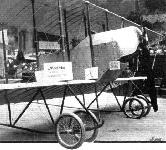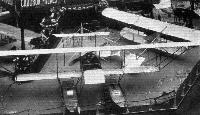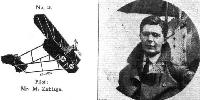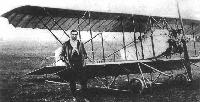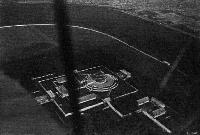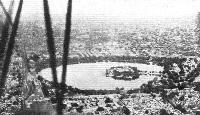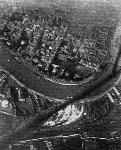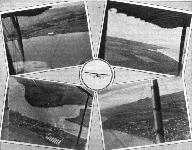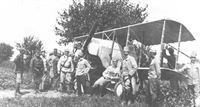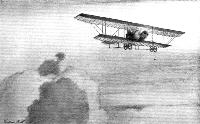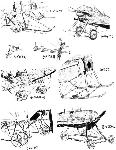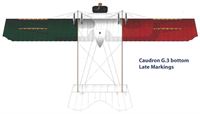В.Кондратьев Самолеты первой мировой войны
КОДРОН G.3 / CAUDRON G.3
Цельнодеревянный двухместный полутораплан с ферменным фюзеляжем и тянущей силовой установкой. Крыло и оперение покрыты полотном, гондола имела смешанную фанерно-полотняную обшивку. Самолет разработан в 1911 году братьями Рене и Гастоном Кодрон. В 1913 принят на вооружение французских ВВС в качестве разведывательной и учебной машины. В том же году несколько десятков "Кодронов" на колесном и поплавковом шасси закупило правительство Китая. G.3 стал таким образом первым военным аэропланом этого государства.
Аппараты строились крупными сериями на заводах фирмы Кодрон в городах Ру, Исси-ле-Мулине и Лион. Главным образом выпускали две военные модификации: G.3A2 (артиллерийский разведчик) и G.3E2 (учебный). В 19 И году производился также одноместный тренировочный G.3F с маломощным 60-сильным мотором. Несколько десятков G.3 построено британским филиалом фирмы - Бритиш Кодрон Компани и еще 170 штук - итальянской фирмой AER. Общий итог серийного выпуска составил 2450 экземпляров.
К началу войны на вооружении французской армии насчитывалось более сотни "Кодронов" GЗ, однако, лишь одна фронтовая эскадрилья . была целиком оснащена этими машинами. В дальнейшем их количество значительно возросло. Самолет применялся французами, англичанами и бельгийцами на западном, балканском, и месопотамском фронтах до середины 1916 года, а на итало-австрийском - до марта 1917. 192 экземпляра G.3 использовали в качестве учебных американские экспедиционные силы.
Несмотря на низкую энерговооруженность, G.3 хорошо набирал высоту, был прост в управлении и доступен даже летчикам низкой квалификации. Тем не менее стремительный прогресс авиации в годы первой мировой войны быстро , перевел его в разряд устаревших. Кроме того, пилоты, в большинстве своем привыкшие к аэропланам с задней силовой установкой, считали обзор из кабины неудовлетворительным.
Около 20 "Кодронов" G.3 в 1915-16 годах поступило в Россию, но данные об их фронтовом применении отсутствуют. Вероятно, все они служили в учебных подразделениях.
ДВИГАТЕЛЬ
На "Кодрон" G.3 устанавливали различные модификации ротативных моторов "Гном", "Рон" или "Клерже" мощностью от 60 до 100 л.с. Иногда ставили стационарный звездообразный мотор воздушного охлаждения "Анзани 10С" в 100 л.с.
ВООРУЖЕНИЕ
На G.3E2 и G.3F - отсутствовало, G.3A2 иногда оснащали шкворневым пулеметом для защиты от истребителей. В перегрузочном варианте - до 100 кг. бомб.
Показать полностью
А.Шепс Самолеты Первой мировой войны. Страны Антанты
Кодрон G.3 1911 г.
После успешных полетов созданных братьями Рене и Гастоном Кодрон машин G.1 и G.2 и славы, пошедшей по всей Европе об их фирме и летной школе в г. Кроти, французская армия выдала в 1912 году государственный заказ на два поплавковых варианта только что выпущенного на заводе G.3 и отдельное задание на обучение большого количества офицеров на военных летчиков. Успешное применение G.3 во Франции привлекло внимание командования британских ВМС, и к 1913 году машина стала стандартной в летной школе в Хендоне. В 1913-1914 годах большое количество G.3 закупил Китай.
С началом войны все учебные и частные "Кодроны" были мобилизованы, а производство перешло на военные рельсы. Первой серией стали разведчики и легкие бомбардировщики G.3 A2, а затем двухместный учебный G.3 E2. Кроме заводов братьев Кодрон самолеты выпускала итальянская фирма AER (170 шт.) и "Бритиш Кодрон Компани" (несколько десятков). В ходе войны машины использовались во французской армии и флоте, в английском экспедиционном корпусе и в самой Англии, в армиях Италии, Бельгии и России. В процессе производства на самолет ставились различные двигатели: ротативные, воздушного охлаждения, звездообразные - "Гном", "Рон", "Клерже" мощностью от 80 до 100 л. с.
Последние машины оборудовались элеронами на верхнем крыле. Однако осенью 1916 - весной 1917 года они были полностью сняты с вооружения практически во всех армиях как устаревшие. Всего было построено 2450 самолетов G.3.
G.3 - цельнодеревянный трехстоечный полутораплан с короткой гондолой. Гондола имела деревянный каркас и фанерную обшивку. Капот двигателя, установленного в носовой части, был из жести. За двигателем устанавливались топливный и масляный баки, также имевшие жестяные панели. Затем располагалось место пилота, в хвосте гондолы - место либо ученика, либо наблюдателя. Крыло двухлонжеронное, деревянной конструкции, имело только одностороннюю обтяжку полотном. Стойки крыла деревянные. Деревянную конструкцию имела и ферма, несущая хвостовое оперение, состоящее из стабилизатора с рулями высоты и двумя рулями поворота на небольших килях.
Шасси устанавливалось по нижнему поясу несущих оперение ферм и состояло из двух пар мотоциклетных колес с резиновой шнуровой амортизацией. Костыля не было, его заменяли окованные нижние части несущего пояса фермы. Управление тросовое, от колонки со штурвалом и педалями. Управление креном осуществлялось перекашиванием крыльев, и только на последних машинах появились элероны.
Двигательная установка, как уже отмечалось, отличалась разнообразием, но в основном это были 7-цилиндровые, воздушного охлаждения, звездообразные "Гном" или "Рон" мощностью 80-100 л. с., ротативные.
Модификации
G.3A2 - разведчик и легкий бомбардировщик, мог нести 115кг бомб, иногда ставился 1 пулемет над верхним крылом и 1 на шкворневой установке у наблюдателя.
G.3E2 - учебный самолет с двойным управлением.
G.3 поплавковый - самолет устанавливался на деревянные поплавки, имевшие ниши, в которые устанавливались колеса, позволявшие использовать машину с земли. Нижний пояс ферм крепился не к полозам шасси, а к нижнему крылу.
ЛЕТНО-ТЕХНИЧЕСКИЕ ХАРАКТЕРИСТИКИ
G.3A2 G.3B2 G.3 амфибия
1911 г. 1914г.
Размах, м 13,40/7,65 13,40/7,65 12,75/9,00
Длина, м 7,30 7,27 8,10
Площадь крыла, кв.м 27,00 28,2 31,0
Сухой вес, кг 445 447 450
Взлетный вес, кг 710 735 700
Двигатели: "Рон"
число х мощность, л. с. 80
Скорость максимальная, км/ч 110 115 105
Время набора высоты, м/мин 2000/20
Дальность полета, км 340 340 300
Потолок, м 3100 3500 2500
Экипаж, чел. 2 2 2
Вооружение 1 пулемет 1 пулемет -
100кг бомб
Показать полностью
В.Шавров История конструкций самолетов в СССР до 1938 г.
"Кодрон" одномоторный 1914 г. (G-3, "Однокодрон") - ферменный двухстоечный биплан с двухместной гондолой (сиденья одно за другим). Двигатель -"Гном", с 1916 г. -"Рон" в 80 л. с. Шасси - фармановского типа, нижние пояса ферм шли почти по земле. Вооружения не было, обзор был плох, но самолет был легок и очень хорошо набирал высоту. Было около 20 импортных экземпляров.
Амфибия "Кодрон" по схеме и конструкции аналогична сухопутному одномоторному самолету "Кодрон", но на двух поплавках, причем колеса проходили сквозь поплавки в специальных гнездах и не имели механизма подъема и выпуска. Было два экземпляра на Черном море.
Самолет|| G-3/Амфибия
Год выпуска||1914/1914
Двигатель , марка||/
мощность, л. с.||80/80
Длина самолета, м||6,8/8,1
Размах крыла, м||13,2/12,75(9,0)
Площадь крыла, м2||28,2/31
Масса пустого, кг||447/450
Масса топлива+ масла, кг||115/70
Масса полной нагрузки, кг||288/250
Полетная масса, кг||735/700
Удельная нагрузка на крыло, кг/м2||26/22,6
Удельная нагрузка на мощность, кг/лс||9,2/8,8
Весовая отдача,%||39/36
Скорость максимальная у земли, км/ч||115/105
Время набора высоты||
1000м, мин||8/15
2000м, мин||20/40
Потолок практический, м||3500/2500
Продолжительность полета, ч.||3/?
Показать полностью
J.Davilla, A.Soltan French Aircraft of the First World War (Flying Machines)
Caudron
Several other aircraft were produced before the war. These included:
<...>
3. Type F single-seater (1913) with either 80-hp Gnome or a 60hp Le Rhone
4. Type G trainer (1912) with 80-hp Gnome or 60-hp Anzani; later developed into G.2.
<...>
The Caudron G.2, G.3, and G.4 proved to be excellent reconnaissance aircraft because of their stability, but their pusher configuration made them vulnerable to fighter attacks from the rear. By the middle of the war the Caudron brothers abandoned the pusher layout.
Caudron G.2
The Caudron G.2 was a tractor biplane that saw limited service during 1914. It featured the central nacelle, unequal span wings, and twin boom and twin rudders of the early Caudron series. The G.2 had an 80-hp Gnome engine, although in some an 80-hp Le Rhone engine was used. The aircraft was constructed of wood with flexible wings, and lateral control was by wing warping. There were apparently two versions, a single-seater and a two-seater. According to the crews of C 11, the observer's view on the two-seater was very poor. The aircraft were assigned to two escadrilles at the beginning of the war.
At the outbreak of hostilities, the commanding officer of the aviation school at Reims offered his pilots' services to the 5th Armee. On August 16 Escadrille CM 39 (for Caudron Monoplace) was formed. There were only four aircraft on strength. A number of reconnaissance missions were flown over Namur (16 August), Chimay (24 August), Guise (30 August), and during the battle of the Marne (1-10 September). After the front stabilized, the pilots were assigned to various Caudron escadrilles (C 11, C 17, and C 30) with Caudron G.3s. In February 1915 CM 39 re-equipped with Caudron G.3s and was re-designated C 39.
Escadrille C 11, at Crotoy, was the other unit that had the G.2 on strength (alongside some G.3s) when the war began. The pilots were reportedly relieved when their escadrille was completely re-equipped with the more modern G.3s.
Foreign Service
Australia
Australia acquired several Caudron G.2s for use at flight training schools.
United Kingdom
The RNAS purchased a single G.2 with a 60-hp Anzani engine. It was based at Hendon.
Caudron G.2 Single- or Two-Seat Trainer with 80-hp Gnome
Wing span 7.25 m, length 12.10 m, wing area 28 sq. m
Loaded weight 400 kg.
Maximum speed 106 km/h, climb 166 meters per minute.
Caudron G.3
The Caudron G.3 was a development of the G.2 and retained the twin-boom configuration with a tractor engine. The first G.3 was built at Rue in May 1913 and was flown from le Crotoy. Before the war the Caudron brothers moved their factory to Lyon, where they built sizable numbers of G.3s. Because the G.3 was one of the few French types in large-scale production when hostilities began, the success of the Caudron brothers was assured. Later the brothers opened a second factory at Issy-les-Moulineaux to handle production orders given to them by the Aviation Militaire as well as many other air forces.
The Caudron G.3 was a single-engine, two-seat biplane. The wing spars were made of ash and spruce with reinforcing strips of metal. The spars were ribbed and had no dihedral. The ribs were fined to the forward spar by slots and were attached to the lower wing by screws. There were 42 ribs in the upper wing and 24 in the lower. Twelve struts held the upper wing in place. The upper wing was longer than the lower, and a pair of struts mounted at an oblique angle connected the tip of the lower wing with the outer portion of the upper wings. This outer portion of the upper wing could be folded back for transport. Roll control was achieved by warping the outer trailing portions of the upper wing. The construction of the stabilizer was similar to the upper wing and initially used warping on the trailing edge; later hinged stabilizers were fitted. The horizontal stabilizer had two spars. The stabilizer was attached to the fuselage by four booms; the two top booms were made of fir and the lower two were made of ash. The end of the lower booms served as landing skids. There were two triangular fins with rudders controlled by foot pedals. The fuselage nacelle was built ol fabric-covered ash and attached to the wings by four struts. The landing gear consisted of a pair of wheels attached to the forward part of the lower fuselage booms. Bungees acted as shock absorbers.
The engine was mounted in the front of the nacelle and was separated from the aft fuselage by an aluminum sheet. The engine was usually a rotary such as a Gnome or Le Rhone, but a fixed Anzani was used on trainers. An aluminum engine cowling was sometimes fitted to protect the crew from oil, smoke, and castor oil. The fuel tank was divided into two parts: one section for fuel with a 100-liter capacity, the other for oil with a 5-liter capacity. It was placed on a wooden floor in the fuselage between the observer and the pilot and had a plywood cover. The position of the crew was unsatisfactory; the observer was located behind the engine and beneath the upper wing where his field of vision was extremely limited. The pilot was seated behind the upper wing, where he also had a limited view ahead. Many operational crews switched places, with the pilot in front and the observer behind, but there were complaints that the G.3 was too difficult to land with this arrangement, and in any event the observer's field of vision was unimproved.
The G.3 was adopted for use by the Aviation Militaire as well as by a large number of foreign air forces. A total of 2,450 were built: 1,423 by Caudron and 1,027 by the SFA, Potez, Bleriot, and Deperdussin.
Variants
There were several major versions of the Caudron G.3s produced during the war;
G.3 A2 - STAe designation lor the artillery cooperation version.
G.3 D2 - STAe designation for two-seat trainer.
G.3 E1 - STAe designation for a G.3 trainer converted to a single-seat configuration.
G.3 E2 - STAe designation for rotary-engine trainer.
G.3 L2 - STAe designation for a G.3 with an Anzani engine. It was used for liaison.
G.3 R1 - STAe designation for a single-seater with a reduced wing span. It was a "penguin" used to train student pilots how to taxi. R signified "rouler."
In service with the Aviation Militaire, the trainer versions of the type G.3 were given the Army designation 12 (XII). Occasionally there is reference to the Caudron G.3 12 (sic).
The observer's position in the G.3, as well as the type's retention of a pusher layout but with a tractor engine, meant that it was virtually impossible to arm the G.3 effectively. Marcel Bloch and Henry Potez were assigned to modify a G.3 so that armament could be carried; Louis Bleriot modified the pilot's control system. These changes, carried out on Caudron G.3 No.985, required that a smaller fuel tank be placed near the knees of the observer and that the main tank between the pilot and observer be reduced in size or eliminated. The type was assigned to the C.R.P. and was test-flown by Capitaine Eteve. He was accompanied on the initial test by Lieutenant Frechet, who had supplied the machine gun. The first test flight was made on 15 July 1915. Apparently the modifications were not widely adopted for use in the standard G.3.
A memo from the SFA in 1915 stated that these modifications were being introduced on the G.3 at the Caudron factory:
1. Modification of the painting technique used on the aircraft.
2. Strengthening of the propellers.
3. Reinforced engine mounts.
4. Introduction of tail flaps on some machines.
Operational Service
The GQG records indicate there were 128 G.3s at the front in August of 1915, along with approximately 31 G.4s. There were a total of 177 G.3s and G.4s by October of 1915, with 161 in service at the front, eight with the R.G.A., seven with training units, and one with the aviation detachment at Vidamee.
By 1 February 1916 there were 141 G.3s in service. They represented 17 percent of the reconnaissance planes still in service and 12 percent of all French types.
C 11 provides an example of the operations of a typical G.3 escadrille. C 11 was formed at Le Brayelle near Douai with six Caudron G.3s. It was stationed here until July 1914, when it was sent to Moltmedy in the 2nd C.A. sector. During August C 11 flew reconnaissance missions in the Battle of the Marne and dropped flechettes on enemy troops. The first wireless experiments were undertaken near Verdun in March 1915. In July C 11 was attached to the R.F.V. and provided reconnaissance to determine the topography of the area and also strafed enemy trenches. In December the escadrille left Verdun and moved to Ancemont near the Meuse. However, poor weather prevented operations in this area, and C 11 was forced to move to a new airfield. On 12 September 1915 the escadrille claimed its first aerial victory, and eight days later C 11 participated in the battles around Champagne, but flights were limited by rain. At this time, the unit's G 3s were used for artillery spotting, long-range reconnaissance, short-range bombing missions against train stations, and aerial combat. In January 1916, despite the aggressive German fighters, three planes of C 11 were able to provide valuable reconnaissance for General Herr of the R.F.V. In April 1916 C 11 was attached to the 2nd C.A., with which it remained for the rest of the war. The unit was considered to be one of the most prestigious reconnaissance escadrilles of the Aviation Militaire. During the early part of 1916 numerous aerial victories were claimed, but C 11’s main mission was still reconnaissance and artillery spotting. Various targets, including St. Mihiel, St. Maurice, and the steelworks at Joeuf-Homecourt, were bombed in April. By the middle ol 1916 the escadrille had completely replaced its G.3s with G.4s.
The Caudron escadrilles had been largely re-equipped with the superior Caudron G.4s by late 1915/early 1916. A GQG order for 12 July 1916 ordered all escadrilles still possessing G.3s to turn them over the G.D.E. (training establishment). By August 1917 there were only 12 G.3s with front-line escadrilles and in the aviation parks, and seven with the R.G.A. Some G.3s were retained by each unit to serve as pilot trainers. Many G.3s retired to the aircraft parks later saw extensive service in training units, where the docile Caudrons proved quite popular. Indeed, many French pilots obtained their license on Caudron G.3s. The G.3s were to be found at most French schools, including Chartres, Etampes, Le Crotoy, Buc, Amberiett, Chateauroux, Bron, Tours, Istres, and Dijon. It took 50 days to obtain a license for a pilot trained in a G.3. Once the license had been granted the pilot might continue to fly the G.3 in advanced training. In 1917 the order in which a pilot was advanced along the training syllabus was: Maurice Farman M.F.11, Voisin, Caudron G.3, and Nieuport fighter. The G.3s served well into 1917 and some were still operational as trainers as late as 1918. The G.3 was remarkably easy to fly and was very stable in flight. These qualities made it an ideal trainer. Takeoff and climb was normally at a speed of 80 to 85 km/h, cruising speed was between 100 and 105 km/h, descent was at 80 km/h, landing approach was at 70 km/h. and the aircraft landed at 55 km/hr.
A few G.3s were used by the Aviation Maritime. On 8 May 1914 Rene Caudron made the first takeoff of an airplane from a French ship. Flying a G.3 amphibian off a temporary platform erected on the forecastle of the seaplane carrier Foudre. A second attempt on 9 June by a naval aviator. Lieutenant de Vaisseau Jean de Laborde, failed when the Caudron struck a piece ol deck gear and crashed into the water. The machine was destroyed but the pilot survived. The accident caused an end to such experiments and the platform was removed from the Foudre.
Foreign Service
Argentina
Argentina received its first G.3 from France in 1918. A year later, six more G.3s were sent to Argentina. An additional 15 G.3s were later assembled at El Palomar. The G.3s served with the Escuela de Aviacion Militar (Military Aviation School) which in 1922 became Grupo de Aviacion 1 (1st Aviation Group).
Australia
Australia acquired a number of G.2s and G.3s for service with flight schools. CFS 9 (Central Flying School 9) had one G.3, purchased in 1916 and retired in 1918. G.3s also served with the Australian Half Flight in Mesopotamia. Two were used by IFC 3 and 4 (Indian Flying Corps).
Belgium
About 66 Caudron G.3s with 80-hp Le Rhones were obtained by Belgium although, surprisingly, not until 1918. The initial batch ol 36 arrived in June/July 1918 at the Ecole de L'Aviation Militaire (Military Flight Training School) at Juvisy; the remaining 30 arrived a short time later.
The aircraft were used to equip the 6th Training Group. By May 1920 the 1st, 2nd, and 3rd Escadrilles were equipped with the type. In September 1924 the G.3s were based at Wevelghem and assigned to the 3rd Groupement of the 2nd Groupe d'Ecolage (Training Group). The school at Juvisy continued to use the aircraft until 1928. Some of the 66 aircraft were used al the civil flight training school at Gosselies. It was intended that graduates of this school would provide a potential pool of flyers if war should break out.
China
On 13 July 1913 the Chinese received 12 Caudrons - eight two-seaters powered by 80-hp Gnome engines (which were G.3s) and four smaller single-seaters with 50-hp Anzani engines (which were probably G.2 s or Type Js).
The French set up a flight school but found the Chinese to be reluctant students. The Chinese Army Flight School at Nayan was a limited success, for by spring 1914 all but one of the Caudrons were unserviceable. Eventually they were repaired and training resumed in May with a class of 40 Chinese army officers. By early 1916 80 students had been graduated and the school had 20 aircraft (some of them G.3s) on strength.
The Caudrons did see active service in China. Several were sent to take part during an uprising in Mongolia. They were based at Kalgan and armed with bombs. However, according to British sources the aircraft "never left the ground."
Three G.3s with 80-hp Gnomes and a single-seater with a 50-hp Anzani were sent to suppress a bandit uprising on 6 April 1914. Each averaged 150 km of flying over seven weeks and were used primarily for reconnaissance. The aircraft were felt to have turned the tide of battle and the lead airman was promised the head of the rebel leader as a reward.
After this demonstration of the effectiveness of aircraft, several G.3s were assigned to support various Chinese divisions in the field. The aircraft saw little active service throughout the remainder of the war as their condition rapidly deteriorated, at least in part due to poor maintenance. By 1920 those machines that remained were described as "useless."
Colombia
The Escuela Militar de Aviacion (Military Aviation School) became operational in April of 1922. It was located at Flandes and obtained three Caudron G.3s in early 1922. They were withdrawn from service in 1925 when the school was closed.
Denmark
The Danish army air service obtained a single Caudron G.3 in 1914. It was powered by a 60-hp le Rhone engine and remained in service until 1922.
El Salvador
Three Caudron G.3s. which had been built in Italy by the A.E.R. firm (see below), were purchased by the Escuela de Aviacion National in 1924. These had serials C-1, C-2, and C-3. One of them, C-3, participated in maneuvers as part ol the First Section of the 1st Squadron in 1924.
Finland
The Finnish air service obtained 12 G.3s in 1920. Six more were built in Finland during 1921-23. Another machine was obtained from a private source. They carried these serials:
1. Twelve Caudron G.3s obtained from France: serials 2A 490-495 (later 1B 1 through 7 and 1D 8 through 12).
2. Six Finnish-built machines: serials 1D 13 and 1E 14-18.
3. A single aircraft obtained from a private source: serial 1B 19.
The Caudron G.3s were not assigned to any of the Flying Divisions but were assigned to the Ilmailukoulu (flying school) at Santahamina. They remained in service until 1924.�
Greece
A number of Caudron G.3s were obtained by the Greek army air service in 1921. They served as trainers at the Sholi Aeroporias Sedes (Sedes Aviation School). One participated in the Campaign in Asia Minor in 1921.
Italy
Italy was in desperate need of adequate combat aircraft when it entered the war in 1915. One of the first types to be obtained was the Caudron G.3. By December 1915 there were five G.3 squadrons on strength. The aircraft were used in the army cooperation role and were organized as artillery Squadriglias.
Caudron G.3s and G.4s were built under license by the A.E.R. plant at Torino. Ninety aircraft were built in 1915, and 80 in early 1916. By the end of the war a total of 250 had been built. Caudron G.3s continued in widespread use as army cooperation aircraft throughout 1916. They were organized as follows:
Gruppo 5 (3rd Armata): 41a, 42a, 43a, and 44a Squadriglias.
Gruppo 6 (3rd Armata): 45a Squadriglia.
By early 1917 the G.3s were replaced by other aircraft, including Caudron G.4s. The G.3s were subsequently used as trainers.
A few remaining G.3s were assigned to 4a Squadriglia in 1917, along with a number of Farmans (probably F.40s). No. 41a Squadriglia was assigned to 2 Gruppo. In April 2 Gruppo was assigned to the 2nd Armata and in November it was with the 4th Armata.
Japan
A single G.3 trainer with an 80-hp Gnome engine was purchased but the type was not adopted by the Japanese army air service.
Peru
A French mission arriving in Peru in January of 1919 brought a number of aircraft including one Caudron G.3 intended for use as a trainer.
Portugal
The Caudron G.3 saw service with the Portuguese air service. Two G.3s were obtained in 1916 and were assigned to the Escola Aeronautica Militar (Military Flight School) at Vila Nova da Rainha. Four additional G.3s were obtained later. In 1918 the school had been redesignated the Escola Militar de Aviacao (EMA) and a new school had been formed at Alverca, designated the Esquadrilha Mista de Deposito (Joint Training and Depot Squadron). It was initially equipped with two G.3s. The G.3s must have been successful trainers, because plans were made to produce them under license by the Parque de Material Aeronautica (Aeronautical Material Park ) or PMA. Deliveries began in 1922 and 50 had been produced by 1924. A few PMA-built G.3s were sent to the Grupo de Esquadrilhas de Aviacao de Angola (Group of Air Squadrons at Angola) in 1922. Production of the G.3 was terminated in 1924. Apparently the G.3s were used exclusively for training.
Romania
France supplied a number of combat aircraft to Romania in 1915 to cultivate the Romanian tilt toward the Allies. Among the aircraft were a dozen Caudron G.3s. On 15 September 1915 the Romanian air corps was created and included in its order of battle three Caudron G.3 units. One unit had four G.3s and was assigned to Grupul 1 (1st Group) as an artillery observation squadron; another had four Caudron G.3s, also in the artillery observation role, and was assigned to Grupul 2, and, finally, a third squadron of four G.3s in the artillery cooperation role was attached to Grupul 3.
By 17 August 1916, when Romania entered the war on the side of the Allies, none of the G.3s was serviceable. As 1916 progressed two of the G.3s were repaired; one was assigned to Grupul 2, the other to Grupul 3. By early 1917 the G.3s had been completely replaced in the reconnaissance role by MF.11s.
Russia
Both the Caudron G.3 and G.4 were obtained from the French by the Russian government and served primarily with long-range reconnaissance and army cooperation squadrons. Unlike many other foreign aircraft, neither the G.3 nor G.4 were selected for license production by the Russian government. It appears that about 20 G.3s were obtained. Soviet sources describe them as being antiquated, yet some saw prolonged service with the Russian air service. The main complaints about the type were the same as those listed by French aviators - the G.3 was unarmed and offered the observer a very restrictive field of view. It was, however, easy to fly and had a relatively rapid rate of climb.
Serbia
The Caudron G.3 was introduced into service in Serbia when Escadrille G 89 was assigned by the French to Serbia in 1916. This unit remained under French control and did not become a combined French-Serbian unit. Apparently, Serbia never obtained any G.3s for its own air service.
Spain
The first G.3 was flown to Spain by a French pilot in May/June 1919. The aircraft was intended for use as a primary trainer. About 18 G.3s were obtained by the Spanish government. By December 1919 they were in service with three of the five training centers in Spain, at Getafe, Sevilla, and Los Alcazares. The training syllabus called for students to solo in the G.3 and, after passing their flight exam, advance to the Avro 504. There were 12 G.3s in service in December 1920 (all with 80-hp Le Rhone engines). By 1924 the G.3s had been replaced completely by Avro 504s.
United Kingdom
Caudron G.3s were first obtained from the French in 1915 to help supplement the rapidly-growing RFC. The first aircraft were assigned to No. 1 Squadron in March 1915. Although about 140 G.3s were obtained, they never saw widespread use with the British reconnaissance units. No. 1 Squadron had four aircraft in May 1915, No.4 Squadron had two, and No.5 Squadron had at least one. The last operational G.3 was removed from service in October 1915.
Several G.3s remained at the 1st Aircraft Park without being assigned to squadrons: the British valued the 80-hp Le Rhone engines more than the airframes to which they were attached. The G.3s were used with greater success in the training role and most of them saw service with the BEF School and 13, 14, 23, and 29 Squadrons. Some were with Nos. 1, 3, 4, 6, 9, and 41 Reserve Squadrons. Finally, two G.3s saw service in Mesopotamia in 1915. The aircraft were sent to Basra in July and were subsequently based at Nasani, where they made reconnaissance flights. One was lost on 30 July, the other was lost 16 September to rifle fire.
The Royal Naval Air Service also used the Caudron G.3. A total of 139 G.3s were employed, mostly as trainers in France. At the beginning of the war there was a single G.3 (No.45) at the Eastchurch Station and it moved to Chingford in May 1915. G.3s built by British Caudron were on strength; these included No.40 and No.1372. Aircraft from France were Nos.1592-7; all but No.1595 had Anzani 100-hp engines (No. 1595 had a 80-hp Gnome); some or all of these may have been Type Js. Twenty-five more G.3s with 80-hp Gnome engines were obtained from France in 1915. They were allocated serials number 3264-3288. Twenty additional G.3s with 80-hp Gnome engines (Nos.3863-3882) were purchased in France during 1915.
In 1916 more G.3s were purchased for service with the Caudron School. These were built by British Caudron and had serials 8941-8950. These G.3s were used almost exclusively for training. Serials N3050-3099 were based at the RNAS at Vendome, while N3264-N3288 were based at the Eastchurch and Eastbourne Stations.
United States
Although the Air Service of the A.E.F. never used the Caudron G.3 operationally, many American pilots were trained on them. A total of 192 G.3s were used by the A.E.F. as trainers. They were considered by the American pilots to be "museum pieces," but they were effective in the primary training role. Most of the G.3s were based at Tours. It has been noted that those at Tours were decrepit and it was believed that many of them had been rebuilt from wrecks. There were 50 or 60 G.3s in service al Tours in the fall of 1917. By January 1918 the number had been reduced to around a dozen. By February an additional 30 G.3s/G.4s were available.
Venezuela
When a French air mission arrived at Venezuela in January of 1921 it brought with it 12 Caudron G.3s and G.4s. These aircraft, along with others brought by the French, were used to establish the Servicio de Aeronautica Militar (Military Air Service). Four additional G.3s were obtained in the mid-1920s.
Caudron G.3 Two-Seat Reconnaissance Aircraft with 90-hp Anzani
Span 13.40 m; length 6.40 m; height 2.50 m; wing area 27 sq. m
Empty weight 420 kg; loaded weight 710 kg
Maximum speed: 112 km/h, climb to 2,000 m in 18 min.; climb to 3,000 m in 32 min.; endurance 4 hours
Armament: usually flown unarmed although the crew was given a standard issue rifle
A total of 2,450 were built.
Caudron G.3s Built by British Caudron: Engines Included 80-hp Gnome, 80-hp Le Rhone, 70-hp Renault, and 80-hp or 100-hp Anzani
Span 13.26 m; length 6.89 m; height 2.59 m; wing area 28.27 sq. m
Empty weight 435 kg; loaded weight 710 kg (80-hp Gnome)
Maximum speed: 105 km/h; climb to 2,000 m in 27 min.; ceiling 3.050 m; endurance 3.5 hours
Armament: usually flown unarmed although the crew was given a standard issue rifle
Approximately 50 were built.
Caudron G.3s Built by A.E.R.: Engines Included the 80-hp Le Rhone (Although Others Used the 100-hp Anzani)
Span 13.40 m, length 6.40 m, height 2.50 m, wing area 27 sq. m
Empty weight 420 kg, loaded weight 710 kg
Maximum speed: 110 km/h; climb to 1,000 m in 8 min.; climb to 2,000 m in 18 min.; climb to 3,000 m in 30 min.; ceiling 4,000 m; endurance 4.0 hours
A total of 250 were built.
Caudron G.3s Built by PMA with 80-hp Le Rhone
Span 13.40 m; length 6.40 m; height 2.70 m; wing area 27 sq. m
Empty weight 448 kg; loaded weight 663 kg
Maximum speed: 115 km/h; climb 143 m/min.; ceiling 4,000 m; range 400 km; endurance 4.0 hours
A total of 50 were built.
Показать полностью
L.Opdyke French Aeroplanes Before the Great War (Schiffer)
Deleted by request of (c)Schiffer Publishing
1913 brought a Type D with a larger Anzani, and some new designs:
Type F: A single-seater looper, flown by Chanteloup. The original pair of rectangular rudders was replaced by the raked triangular shapes which characterized the G-3.
Type G: A 2-seater, also with the new triangular rudder shape.
(Wing area: 30 sqm; weight: 350 kg; 80 hp Gnome, 60 hp Anzani)
Type G 2: This pretty 2-seater appeared in Jan 1914.
(Wing area: 27 sqm; weight: 350 kg; 80 hp Le Rhone)
Type G 3: This most famous of all the early Wartime Caudron types first flew in May 1914.
Показать полностью
M.Goodall, A.Tagg British Aircraft before the Great War (Schiffer)
Deleted by request of (c)Schiffer Publishing
BRITISH CAUDRON biplane Type G
A larger and stronger version of the Caudron design appeared as an amphibian in the summer of 1913. Twin sprung floats, with apertures housing the wheels, were fitted on a new chassis. The lower longerons were raised at the front to connect to the intersection of the wing rear spars and to the intermediate interplane struts. A pair of cylindrical wingtip floats and two triangular shaped floats, enclosed by skids, supported the tail on land. A pair of small fins and curved rudders were fitted.
Several of the type were used by the RNAS, but these were mainly of French origin, although Hewlett & Blondeau was reported to have one in hand for Ewen in August 1913. A three-seater version was advertised by Ewen in July 1912 at ?960.
The RFC acquired a number of the land-plane version, known as the G.3, mainly from France, orders still being placed as late as September 1917, although at least fifty were supplied from the Cricklewood factory. The aircraft was used for reconnaissance in early operations, but was employed mainly for training.
For the land-plane version the longerons reverted to their original low position with front extensions to serve as skids. The original engine was a 80hp Gnome, but in wartime a variety of engines was used. The data is for a Type G amphibian with 80hp Gnome engine.
Power:
80hp Gnome seven-cylinder air-cooled rotary.
100hp Gnome Monosoupape nine-cylinder air-cooled rotary.
80 & 100hp Anzani ten-cylinder air-cooled radials.
70hp Renault eight-cylinder air-cooled vee.
Data Amphibian
Span top 42ft
Span bottom 28ft
Chord 5ft lin
Area 350 sq ft
Length 26ft 8in
Area tailplane 50 sq ft
Area rudders 16 sq ft
Data G.8. Land-plane.
Span top 43ft 6in
Area 304 sq ft
Length 22ft 7in
Height 8ft 6in
Weight 959 lb
Weight allup 1,565 lb
Speed 65 mph
Climb to 6,500ft 27 min
Ceiling 10,000ft
Показать полностью
O.Thetford British Naval Aircraft since 1912 (Putnam)
CAUDRON G.3
The RNAS used 140 of these aeroplanes. mostly for training purposes at Vendome in France. The G.3 was the single-engined forerunner of the G.4 and earlier G.2s (Nos.40, 55, 56 and 57) were in service as seaplanes with coastal air stations prior to 1914. No.55, an amphibian, was embarked in HMS Hermes at Great Yarmouth in July 1913 and operated from the forward flying-off deck. The pre-war Caudrons had an 80 hp or 100 hp Gnome engine. Some G.3s. like No.3066 illustrated, mounted the 100hp Anzani engine. Loaded weight, 1.619 lb. Maximum speed, 70 mph. Climb, 20 min to 6.500 ft. Service ceiling. 10.000 ft. Span, 43 ft 5 in. Length, 22 ft 6 in.
Показать полностью
G.Swanborough, P.Bowers United States Military Aircraft Since 1909 (Putnam)
CAUDRON G-IIIE-2 AND G-IVA-2
Two separate but related French Caudron models were used by the A.E.F. as trainers. The G-IIIA-2, originally an observation, or “Corps d’Armee” type of 1914/15, was a single-engined two seater used in 1918 as a primary trainer. The pilot and student sat in tandem in a “bath tub” nacelle behind an 80-h.p. Le Rhone 9-cylinder rotary engine or a 90-h.p. 10-cylinder twin-row Anzani radial. The tail surfaces were supported by tail booms in the manner of contemporary pusher types, but in the Caudron designs the lower booms formed part of the main landing gear and also served as the tailskids. The airfoil was single-surface aft of the rear spar, and late versions of the 192 A.E.F. G-IIIE-2s (“E” indicated “Ecole”, sometimes “Entrainment”, or trainer, in French nomenclature) used ailerons in the upper wing in place of the original wing warping.
<...>
Показать полностью
A.Jackson British Civil Aircraft since 1919 vol.1 (Putnam)
CAUDRON G.3
Two-seat trainer powered by one 90-h.p. Anzani, designed in France 1912 and built under licence by the British Caudron Co. Ltd. at Cricklewood 1914-18. Nine British civil aircraft only, as shown in Appendix D. In use for a few months only in 1919 for instruction and passenger flights and by Brooklands private owners G. Eyston and L. C. G. M. Le Champion. French built OO-ELA, illustrated, 100-h.p. Anzani, bought from M. J. E. Leduc by K. H. F. Waller and ferried Brussels-Brooklands 20.5.36. Registration G-AETA not taken up, now preserved by the Royal Aeronautical Society. Span, 43 ft. 5 in. Length, 22 ft. 6 in. Tare wt., 981 lb. A.U.W., 1,619 lb. Max. speed, 71 m.p.h. Cruise, 56 m.p.h.
Показать полностью
P.Grosz, G.Haddow, P.Shiemer Austro-Hungarian Army Aircraft of World War One (Flying Machines)
Caudron G 3
The Caudron G 3 pusher was one of two Caudron biplanes flown by the French pilot Pierre Chanteloup in the Third International Flugmeeting at Aspern in June 1914. Out of 32 entries, Chanteloup took eighth place. The Caudron G3, confiscated by the military authorities on 13 August 1914, is believed to have been Chanteloup's machine.
Caudron G 3 00.06
The Italian Caudron G 3 C 507 was captured by Flik 4 on 4 July 1915. Pilot Feldwebel Max Brociner flew the G 3, with black crosses covering the Italian roundels, for the first time on 27 July 1915 and went on to perform eight reconnaissance flights over enemy territory in August. Curiously, it was the only flight-ready aircraft reported by Flik 4 on 16 August 1915!
Показать полностью
E.Hauke, W.Schroeder, B.Totschinger Die Flugzeuge der k.u.k. Luftfahrtruppe und Seeflieger 1914-1918
00. Versuchs- und Beuteflugzeuge (Опытные и трофейные самолеты)
00.06 Caudron G.3 C.507 (italienisch) Gn 80
Показать полностью
J.Davilla Italian Aviation in the First World War. Vol.2: Aircraft A-H (A Centennial Perspective on Great War Airplanes 74)
Caudron G.3
Italy was in desperate need of adequate combat aircraft when it entered the war in 1915. One of the first types to be obtained was the Caudron G.3, along with Nieuport 10, Macchi Parasols, Voisin 3s, and Farman M.F.11s. Of these the Nieuport 10 and Macchi Parasol (the only indigenous design) were quickly withdrawn and more Caudron G.3s purchased.
The first 15 G.3s would be delivered in June and AER (established in Turin in April 1915) was also to produce the type under license.
The Parasol Macchi was replaced in five of the Squadriglia Artiglieria (Artillery Squadrons) by the Caudron G.3 with 30 machines being supplied by France and 10 more to follow.
Caudron G.3s and G.4s were built under license by the AER plant at Torino. Ninety aircraft were built in 1915, and 80 in early 1916, bringing the total built to 170 examples. This brought the total number of G.3s built in Italy and obtained in France to 224.
The Fiat A.10 and the 150 hp Isotta-Fraschini would eventually replace the rotary engines, with the exception of the 80-hp Le Rhone, destined for the Caudron G.3s, whose production was about to start under license by AER. Even the Caudron G.3’s Le Rhone proved difficult for the Italian industry to produce under license.
It was soon realized that the Caudron G.3’s 80-hp engines were simply not powerful enough to permit them to operate in bad weather.
Trials were performed with a G.3 equipped with radios; the radios chosen were SFR and Marconi sets. The SFR proved superior and some of these raids were sent to 4a in November 1915.
As the war progressed the 165-mm focal length cameras were replaced by 240- and 430-mm types with magazines carrying up to 24 plates.
Operational Service
By December 1915 there were five G.3 squadriglias on strength. The aircraft were used in the army cooperation role and were organized as artillery Squadriglias.
During the Fourth Battle of the Isonzo (10 November - 2 December 1915) the G.3 OOB was:
1a and 5a Squadriglias Caudron G.3 at Oleis assigned to 2a Armata
2a and 3a Squadriglias at Macchi Parasol at Medeuzza (in the process of converting to Caudron G.3s)� 4a Squadriglia Caudron G.3 at Gonars at the disposition of 3a Armata
At the end of 1915 the artillery squadriglias, 1a, 2a, 3a, 4a, 5a, all used Caudron G.3s. Each Squadriglia consisted of 3 seziones with three G.3s each, plus a tenth in reserve.This arrangement permitted the various seziones to be deployed to the areas of the front where they were most needed.
1916
In the first four months of 1916, 39 G.3s had been sent to front line units. During 1916 the G.3 were 41, 42, 43, 44, 45, 46, and 47 Squadriglias.
Caudron G.3s continued in widespread use as army cooperation aircraft throughout 1916. They were organized as follows:
III Gruppo (1a Armata): 46a (sezione of Caudron G.3s) and 50a Squadriglias (M.F.11s).
V Gruppo (3rd Armata): 41a, 42a, 43a, and 44a Squadriglias.
VI Gruppo (3rd Armata): 45a Squadriglia.
By early 1917 the G.3s were replaced by other aircraft, including Caudron G.4s. The G.3s were subsequently used as trainers.
A few remaining G.3s were assigned to 41a Squadriglia in 1917, along with a number of Farmans. No. 41a Squadriglia was assigned to 2 Gruppo. In April 2 Gruppo was assigned to the 2nd Armata and in November it was with the 4th Armata.
Crews had been forced to fly in an active war zone in a design which was clearly outdated. The problem was the continued problems with the Savoia Pomilio firm. The plan to replace the Caudron G.3s with the Savoia-Pomilio SP.2s and SP.3s was blocked by problems discovered with the design during testing. As both development and production issues with Pomilios was being dealt with, there was no choice but to keep the seriously outdated French machines on the front lines.
On 9 July, Caudron G.3 605, which had been hit by antiaircraft artillery during a photographic survey of the Portule ridge, crashed on the northern slopes of the Armentera. The shooting down of this aircraft, with the death of its crew once again raised the question of the appropriateness of continuing to use the G.3. The limited performance of the type, coupled with its vulnerability to fighters (it was virtually unarmed because of the configuration of its airframe, meant that army commanders had to limit its depth of penetration over the lines to 5 km. This episode thus contributed to hastening the dissolution of the Caudron squadriglias, which took place on 17 August, 1917 with the dissolution of 49a. The Caudrons would be replaced by SP.3s, which, were themselves vulnerable to fighters due to their pusher configuration. Yet, even as the S.P.2 and 3 crews were still being trained for operations after their arrival at the front, it was necessary to continue to use the G.3s in 42a, 43a, and 44a.
By late 1916 the G.3s were being withdrawn from the front and sent to school units. The main training units were Cameri, Centocelle (school for observers), Mirafiori, San Giusto, and Venarai in 1916. According to Alegi the G.3bis with a 120-hp Le Rhone engine was built specifically for the school; the need was so great for the aircraft that the production line reopened in 1918!
Caudron G3s Built by A.E.R.: Engines Included the 80-hp Le Rhone
Wingspan 13.40 m, length 6.40 m, height 2.50 m, wing area 27 sq.m
Empty weight 420 kg, loaded weight 710 kg
Maximum speed: 110 km/h; climb to 1,000 m in 8 min.; climb to 2,000 m in 18 min.; climb to 3,000 m in 30 min.; ceiling 4,000 m; endurance 4.0 hours
A total of 250 were built.
Показать полностью
Журнал Flight
Flight, February 8, 1913.
FOREIGN AVIATION NEWS.
Caudrons for China.
A DOZEN Caudron biplanes of the latest type have been ordered by the Chinese Government, some to be fitted with 50 h.p. and some with 80-h.p. engines. Obre has gone to China, where he will assist Lieut. Bon, of the French colonial forces, in organising an aviation centre at Pekin.
Flight, December 13, 1913.
THE STANDS AT THE PARIS AERO SHOW.
CAUDRON.
On the stand adjoining that of the Deperdussin, Caudron Brothers are showing two machines, one for work overland and the other a hydro-aeroplane. The land machine differs in constructional details only from those already known to our readers through illustrated descriptions in the columns of FLIGHT. The hydro-aeroplane is of the "pusher" type, and has a nacelle of somewhat different shape from those usually fitted. The floats are similar to those fitted on the tractor type of machine, the chassis possessing wheels as well as floats, so that the machine is really amphibious.
Flight, December 20, 1913.
THE PARIS AERO SALON - 1913.
CAUDRON
<...>
The other machine exhibited is a military two-seater land machine. It is driven by an 80 h.p. Gnome engine, mounted on the front of the usual type of Caudron fuselage. In the rear portion of the fuselage are the pilot's and passenger's seats, the pilot occupying the rear seat. The controls are as usual, consisting of a single lever for the warp and the elevator, and a foot-bar for the rudder. The chassis is of the familiar type, with the skids extended backwards to form the lower tail-booms. This machine is similar in every way to those now in use in this country, but one notices that all the strut sockets are now made of steel instead of aluminium as on earlier machines. This, we think, must be considered a distinct improvement as steel sockets are very much stronger, weight for weight, than aluminium sockets.
Flight, May 22, 1914.
THE AERIAL DERBY.
THE PILOTS AND HOW TO RECOGNISE THE MACHINES.
No. 3. The 60 h.p. Caudron Biplane
is somewhat similar to machine No. 1, but may be identified by means of its nacelle which is differently shaped from that of the above-mentioned machine.
THE MACHINES AND HOW TO RECOGNISE THEM.
No. 3. The 60 h.p. Caudron Biplane is similar in its general arrangement to the Statax engined Caudron, with the exception that it has a standard type nacelle. The engine, a 60 h.p. Gnome, is partly enclosed in the usual way by an aluminium shield.
Flight, July 17, 1914.
EDDIES.
I HEAR very good accounts of the work done with the fleet of Caudron biplanes which were sent out to China some time ago. They are daily putting in a great amount of useful flying, and have fully justified the Chinese Government in selecting this type of machine on account of the ease with which they are mastered by pupils and their suitability for landing on the roughest ground, in addition to the other excellent qualities possessed by the products of the Caudron brothers. The accompanying photographs showing Pekin and Tientsin from above were taken by Mr. Rene Caudron, who, thanks to the stability of his mount, was able to let go of the control lever for considerable periods, in order to secure the snap-shots.
Flight, October 22, 1915.
CONSTRUCTIONAL DETAILS.-VII.
<...>
Another form of double skid undercarriage is shown in the sketch illustrating the Caudron chassis. Here, as in the Farmans, the skids are supported on struts running up to the lower wing, but the skids are extended right back to the tail, and form, in fact, the lower booms of the outrigger carrying the tail planes. An excellent retarding effect when landing is one of the immediate results obtained by these long skids, and the Caudrons probably pull up more quickly than any other machine of similar weight and area.
<...>
Flight, August 28, 1919.
THE E.L.T.A. SHOW
The French Section
At the time of writing, the aircraft industry of our gallant ally France is represented by two machines only, a very ancient type of Caudron, and a military type Breguet, of the type used so extensively during the War. It is somewhat of a disappointment that French aviation is not more fully represented, and we trust that before the exhibition closes this will be remedied.
THE MESSAGERIES AERIENNES
which is a combine of the French firms of Bleriot, Breguet, Caudron and Morane, show two machines. One of these is a type G 3 Caudron which will be well known to all our readers. It has a le Rhone engine of 80 h.p., and is characterised by the usual short nacelle and open tail booms associated with the Caudron machines. It might be pointed out that it was on a similar machine that Poulet established a duration record of 16 hrs. 28 mins. in May, 1914. It has also been used very extensively for training purposes, and many of the French "Aces" have got their ticket on machines of this type. Incidentally this type of machine was, we believe, the first biplane to loop the loop, which it first did piloted by Chanteloup on September 17, 1913. The type, although many may be inclined to smile at it in these days, has therefore a long and honourable career behind it, and for landing on or starting from difficult ground it is probably unexcelled by any other machine. For instance, it may be recollected that it was on a machine of this type that the late Jules Vedrines landed on the roof of the Galleries Lafayette. Another similar machine is busy carrying passengers from the E.L.T.A. aerodrome.
<...>
Показать полностью


































